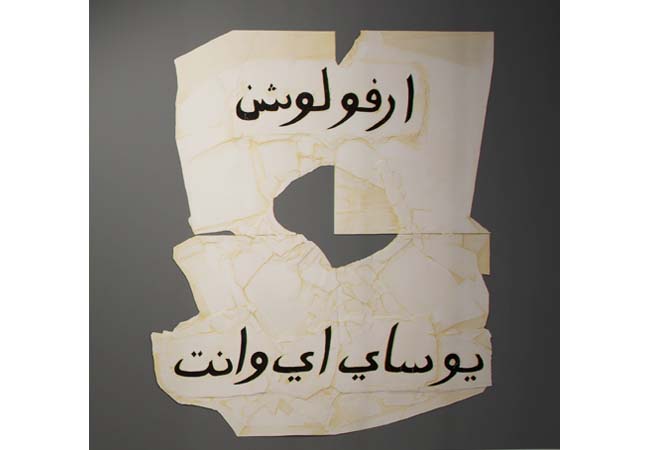 April 18, 2013
April 18, 2013 The Emo Show: Maymanah Farhat
 Annabel Daou, “you say i want a revolution" (pieces of the wall, 2); 2012; Paper, gesso, acrylic, ink on mat board; 80 x 69 ½ inches
Annabel Daou, “you say i want a revolution" (pieces of the wall, 2); 2012; Paper, gesso, acrylic, ink on mat board; 80 x 69 ½ inches
Kevork Mourad’s “The First Day of Spring” (2012) and “Black Knight” (2012) reference the Syrian uprising. The former marks the early, non-violent protests in the village of Dara’a that ignited widespread revolt; the latter depicts Syria’s descent into violence as the country implodes under internal and external pressures. The billowing masses that are surrounded by empty space consist of intertwined bodies: limbs, wings, torsos, and faces; swelling together they become a single force. In both, Mourad draws inspiration from the gestural techniques of Arabic calligraphy, which in the tradition of its many uses, takes form as an evocative means of transmitting the emotive content of language, including that which signals the sublime and/or the erotic.
Annabel Daou’s “You Say I Want a Revolution” (pieces of the wall 2) (2012) transliterates the classic Beatle’s refrain into phonetic Arabic while also altering the directive nature of its lyrics. At once ambiguous and assertive, Daou’s transcription appears on a worn, pockmarked surface, a wall consisting of loosely adhered pieces in the early stages of its formation, or perhaps in its final state of disintegration.
Sumayyah Samaha’s “Magic” contains a cyclone of love and turmoil and tranquility and chaos in a mass that overcomes the expanse of a white void. In suspending all descriptive content and subjectivity, “Magic” relies on medium, color, and composition to translate such stimuli, an approach that, when closely considered under the theme of compassion, parallels the ways in which Mourad and Daou prompt the viewer to consider if the affecting nature of form can also engage the political.
* * * * * * * * * * * * * * * * * * * * * * * *
Maymanah Farhat is a New York-based art historian focusing on the Arab world and its diaspora. Her essays have been featured in a number of monographs, exhibition catalogues, e-zines, and journals. Her reviews have appeared in Monthly Review, ArtAsiaPacific magazine, and Callaloo: Journal of African Diaspora Arts and Letters, among others.